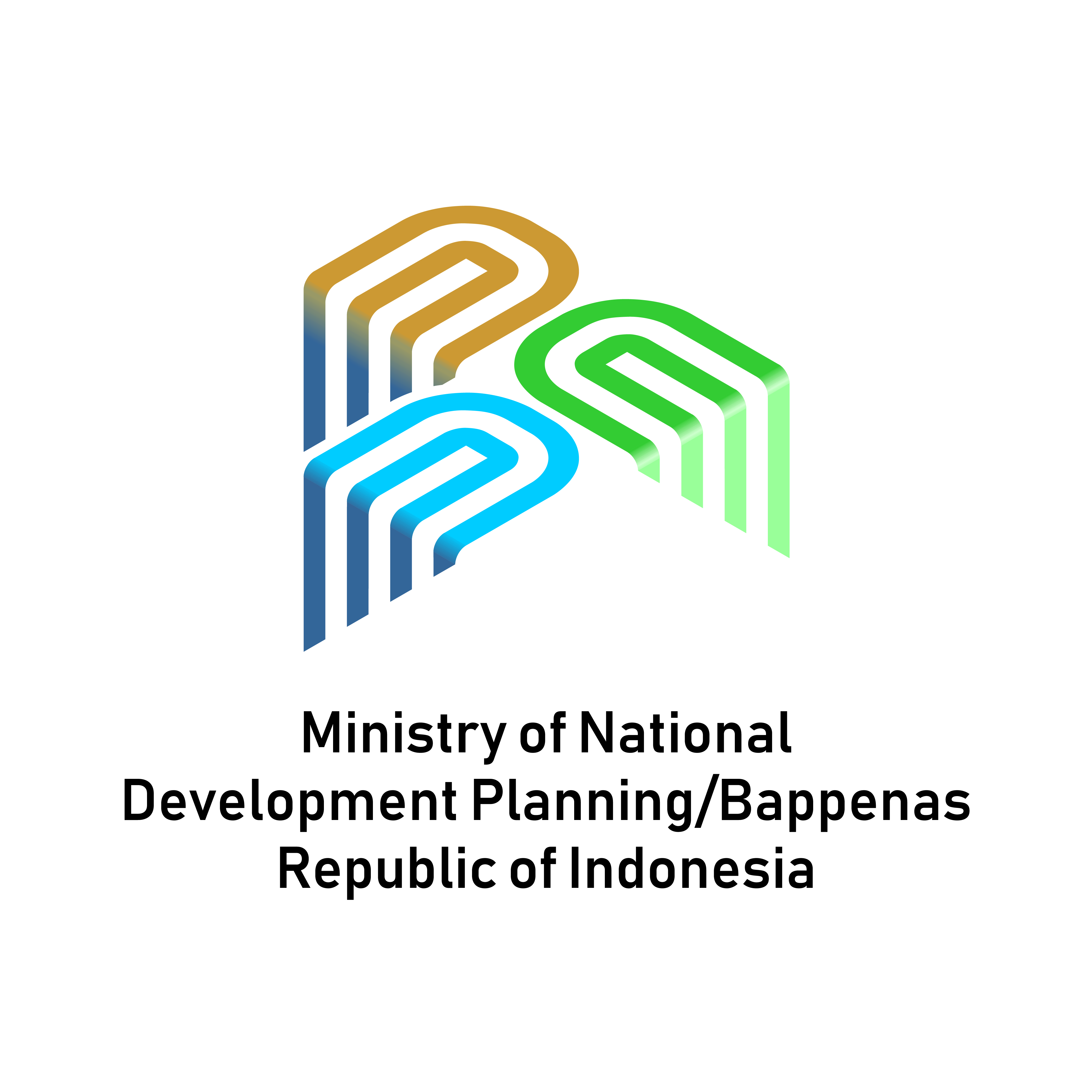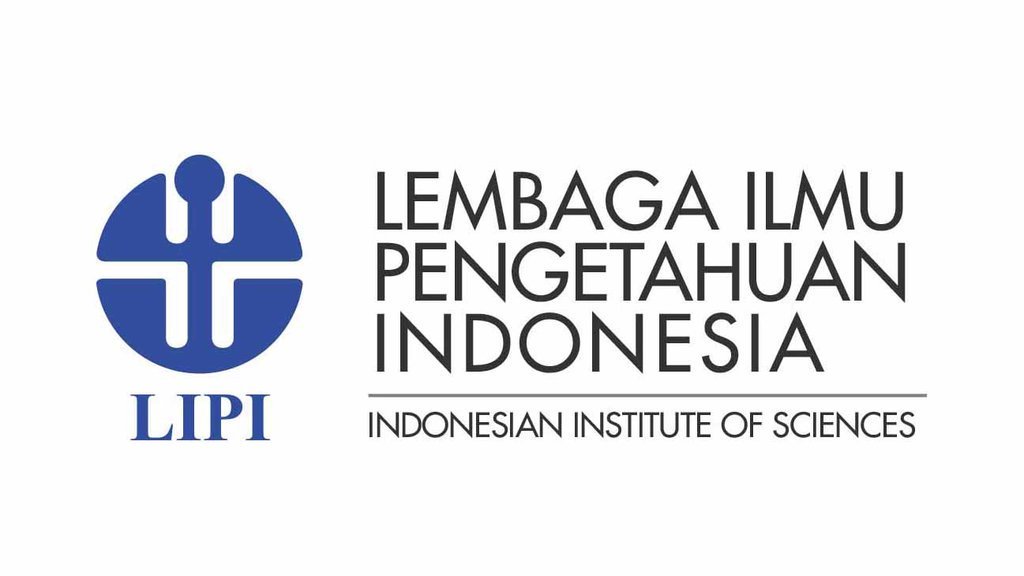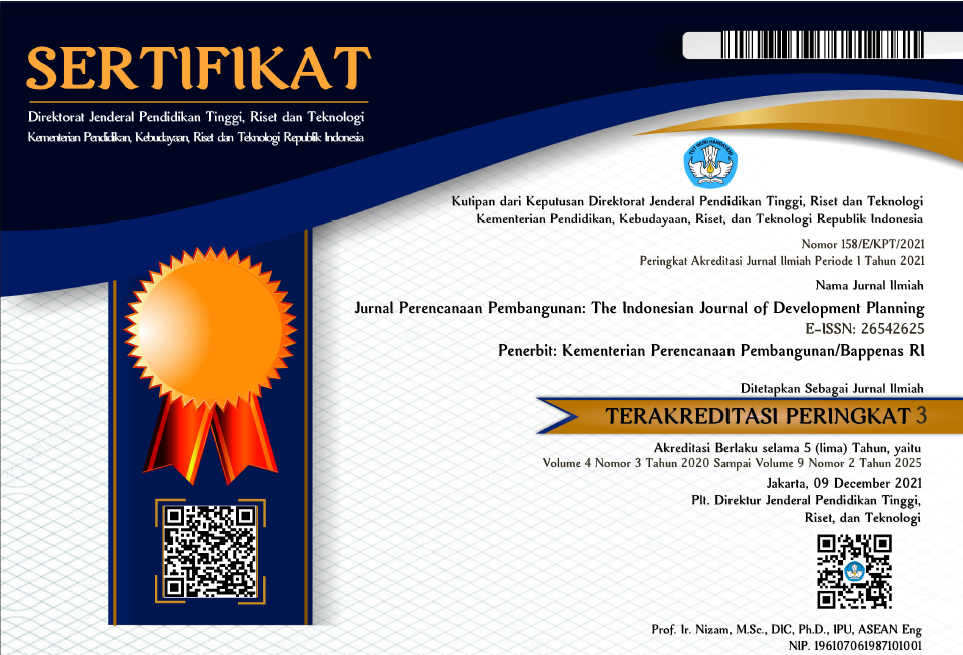The Impact of Village Cash Transfer on Rural Households’ Economic Well-being
DOI:
https://doi.org/10.36574/jpp.v7i2.459Keywords:
Village Cash Transfer, rural, economic well-beingAbstract
Indonesia applied adjustments and refocused the policy of using the Village Funds budget to minimize the impact of the Covid-19 pandemic in 2020, especially in the rural area. The Village Funds have been used as a social safety net as Village Cash Transfer. The researchers carried out this study to present an overview of the evaluation of the effects of Village Cash Transfer on the economic well-being of rural communities in every household quintile. This study uses data on the characteristics of 35,759 households obtained from merging results of the March & September 2020 Susenas data with the Village Fund data in each district/city area. Data were analysed using Smoothed Instrumental Variables Quantile Regression, which overcame endogeneity issues and produced robust estimates. The study results show that the Village Cash Transfer has a positive and significant impact on the economic well-being of rural households. Still, their impact is felt more by the upper middle quintile households, which benefit more from Village Cash Transfer households in the Java region. As a result, it is advisable for Governments to be more generous in providing benefits to families in the lowest quantile and to monitor the program by the requirements of beneficiaries closely.
Downloads
References
Ambia, A.N. & Sujarwoto, N.I. (2018). Infrastructure Expenditure and Poverty Reduction in Indonesia. RJOAS, 4(76), April. DOI https://doi.org/10.18551/rjoas.2018-04.05.
Arcand, J.L & Bassole, L. (2008). Does community driven development work? Evidence from Senegal. SSRN. https://doi.org/10.2139/ssrn.1265231.
Arifin, B., Wicaksono, E., Tenrini, R. H., Wardhana, I. W., Setiawan, H., Damayanty, S. A., Solikin, A., Suhendra, M., Saputra, A. H., Ariutama, G. A., Djunedi, P., Rahman, A. B., & Handoko, R. (2020). Village Funds, village-owned-enterprises, and employment: Evidence from Indonesia. Journal of Rural Studies 79: 382-394.
Asuman, D., Ackah, C. G., & Agyire-Tettey, F. (2021). Disability and Household Welfare in Ghana: Costs and Correlates. Journal of Family and Economic Issues (2021) 42:633–649. https://doi.org/10.1007/s10834-020-09741-5.
Attanasio, O. & Mesnard, A. (2006). The impact of a conditional cash transfer programme on consumption in Colombia. Fiscal Studies, 27(4), 421–442.
Badan Kebijakan Fiskal Kementerian Keuangan RI. (2017). Laporan Kajian Manfaat Dana Desa dalam Percepatan Pembangunan dan Pengentasan Kemiskinan Desa. Pusat Kebijakan APBN, Badan Kebijakan Fiskal Kemenkeu RI.
Badan Kebijakan Fiskal Kementerian Keuangan RI. (2018). Kajian Dana Desa: Analisis Empiris Badan Usaha Milik Desa, Kesempatan Kerja, dan Infrastruktur pada Seribu Desa di Indonesia. Badan Kebijakan Fiskal Kemenkeu RI.
Badan Pusat Statistik. (2020). Keadaan Ketenagakerjaan Indonesia Agustus 2020. https://www.bps.go.id/pressrelease/2020/11/05/1673/agustus-2020--tingkat-pengangguran-terbuka--tpt--sebesar-7-07-persen.html.
Badan Pusat Statistik. (2021). Profil Kemiskinan di Indonesia September 2020. https://www.bps.go.id/pressrelease/2021/02/15/1851/persentase-penduduk-miskin-september-2020-naik-menjadi-10-19-persen.html.
Bappenas, Kompak. (2017). Policy Analysis Village Funds and Poverty Alleviation.
Beath, A., Christia, F., & Enikolopov, R. (2015). Randomized Impact Evaluation of Afghanistan’s National Solidarity Programme.
Bengtsson, F. & Lindblad, K. (2020). Methods for Handling Missing Values. A simulation study comparing imputation methods for missing values on Poisson distributed explanatory variable. Department of Statistics Uppsala University.
Boonperm, J., Haughton, J., & Khandker, S. R. (2013). Does the Village Funds matter in Thailand? Evaluating the impact on incomes and spending. Journal of Asian Economics, 25, 3-16.
Cahyadi, N., Syamsulhakim, E., Wibisono, I. D., & Murniati, S. (2020). Cumulative impacts of conditional cash transfer programs: Experimental evidence from Indonesia. American Economic Journal: Economic Policy, 12(4), pp. 88-11.
Chaudhury, N., Friedman, J., & Onishi, J. (2013). The World Bank Philippines conditional cash transfer program impact evaluation 2012. Human Development Sector Unit East Asia and Pacific Region, Report Number 75533-PH, 1–80. http://documents.worldbank.org/curated/en/537391468144882935/pdf/755330REVISED000Revised0June0402014.pdf
Chandoevwit, W., & Ashakul, B. (2008). The impact of the Village Funds on rural households. TDRI Quarterly Review, 23(2), 9–16.
Chernozhukov, V. & Hansen, C. (2005). An IV model of quantile treatment effects. Econometrica 73 (1), 245–262.
Chernozhukov, V., Hansen, C., & Wuthrich, K. (2020). Instrumental Variable Quantile Regression. https://arxiv.org/pdf/2009.00436.pdf.
Ernawati, Tajuddin, & Nur, S. (2021). Does Government Expenditure Affect Regional Inclusive Growth? An Experience of Implementing Village Funds Policy in Indonesia. Economies 9: 164. https://doi.org/10.3390/economies9040164.
Fitriana, N.E. & Qibthiyyah, R.M. (2021). Pengaruh Kebijakan Dana Desa terhadap Jumlah Penduduk Miskin Pedesaan di Indonesia. Jurnal Ekonomi dan Kebijakan Publik Indonesia: Volume 8, No. 1, Mei 2021 ISSN: 2442-7411.
Daidone, S., Davis, B., Handa, S., & Winters, P. (2017). The household and individual-level economic impacts of cash transfer programmes in sub-Saharan Africa. Rome, Italy: Food and Agriculture Organization of the United Nations.
Duflo, E. (2003). Grandmothers and granddaughters: Old-age pensions and intrahousehold allocation in South Africa. World Bank Economic Review, 17(1), 1–25.
Falkingham, J., & Namazie, C. (2002). Measuring health and poverty: A review of approaches.https://assets.publishing.service.gov.uk/media/57a08d46ed915d622c0018bd/Measuring-health-and-poverty.pdf
Furno, M. (2020). Returns to Education and Gender Wage Gap Across Quantiles in Italy. Central European Journal of Economic Modelling and Econometrics.
Gujarati, D. N., Porter, D. C. (2009). Basic econometric, Fifth Edition. Singapore: MacGraw-Hill Book Co.
Golan, J., Sicular, T., & Umapathi, N. (2017). Unconditional cash transfers in China: Who benefits from the rural minimum living standard guarantee (Dibao) program? World Development, 93(1306), 316–336.
Ha, T. (2021). The effects of COVID-19 and response measures on poverty, household income and household consumption expenditure in South Korea. Journal of Economic Studies. DOI 10.1108/JES-09-2021-0453.
Hadna, A. H., & Askar, M. (2022). The impact of conditional cash transfers on low-income individuals in Indonesia. Advances in Southeast Asian Studies, 15(1), 23-41.
Hartojo, N., Ikhsan, M., Dartanto, T., & Sumarto, S. (2022). A Growing Light in the Lagging Region in Indonesia: The Impact of Village Funds on Rural Economic Growth. Economies 10: 217. https://doi.org/10.3390/economies10090217.
Indonesia. (2014). Peraturan Pemerintah No. 60 Tentang Dana Desa yang Bersumber dari Anggaran Pendapatan dan Belanja Negara.
Indonesia. (2014). Undang-Undang Nomor 6 Tahun 2014 tentang Desa.
Jehle, G.A. & Reny, P.J. (2011). Advanced Microeconomics Theory, 3rd edition. England: Pearson Education Limited.
Joetarto, B., Setiawan, A., & Farida. (2020). The Impact of Village Funds Program on Improving Well-being. Journal of Economics and Policy, Vol. 13 (2):345-366, DOI: https://doi.org/10.15294/jejak.v13i2.24395.
Kaplan, D.M. (2022). Smoothed instrumental variables quantile regression. The Stata Journal (2022) 22, Number 2, pp. 379–403. DOI: 10.1177/1536867X221106404.
Kementerian Desa, Pembangunan Daerah Tertinggal, dan Transmigrasi. Peraturan Menteri Desa, Pembangunan Daerah Tertinggal, dan Transmigrasi No. 14 Tahun 2020 tentang Prioritas Penggunaan Dana Desa Tahun 2020.
Kementerian Keuangan Republik Indonesia. (2017). Buku Saku Dana Desa. Jakarta: Kementerian Keuangan Republik Indonesia.
Kementerian Keuangan, R. I. (2017). Buku Pintar Dana Desa. Jakarta.
Kementerian Koordinator Bidang Kesejahteraan Rakyat. (2007). Pedoman Umum PNPM Mandiri. Jakarta.
Kementerian Sekretariat Negara RI. (2014). Arah Strategis PNPM dan Keberlanjutan Program Pemberdayaan Masyarakat dalam Konteks Undang-undang No. 6 Tahun 2014 tentang Desa.
Klugman, J. (2002). A Sourcebook for Poverty Reduction Strategies. Volume 1: Core Techniques and Cross-Cutting Issues. Washington D.C.: The World Bank.
Koenker, R. & Bassett, G. (1978). Regression Quantiles. Econometrica, Vol. 46, No. 1.
Lewis, B. D. (2015). Decentralising to Villages in Indonesia: Money (and Other) Mistakes, Public Administration and Development, 35.5: 347–359.
Ma, W., Nie, P., Zhang, P., & Renwick, A. (2020). Impact of Internet use on economic well-being of rural households: Evidence from China. Review of Development Economic. 2020;00:1–21. DOI: 10.1111/rode.12645.
Martin, A., Markhvida, M., Hallegatte, S., & Walsh, B. (2020). Socio-Economic Impacts of COVID-19 on Household Consumption and Poverty. Economics of Disasters and Climate Change 4:453–479. htps://doi.org/10.1007/s41885-020-00070-3.
Meyer, B.D. & Sullivan, J.X. (2003). Measuring The Well-Being of The Poor Using Income and Consumption. The Journal of Human Resources XXXVIII Supplement.
Newman, J., Pradhan, M., Rawlings, L. B., Ridder, G., Coa, R., & Luis Evia, J. (2002). An impact evaluation of education, health, and water supply investments by the Bolivian Social Investment Fund. The World Bank Economic Review, 16(2), 241–274.
Parajuli, D., Acharya, G., Chaudhury, N., & Thapa, B. B. (2012). Impact of Social Fund on the Welfare of Rural Households: Evidence from the Nepal Poverty Alleviation Fund. The World Bank.
Permatasari, P., Ilman, A. S., Tilt, C. A., Lestari, D., Islam, S., Tenrini, R. H., Rahman, A. B., Samosir, A. P., & Wardhana, I. W. (2021). The Village Funds Program in Indonesia: Measuring the Effectiveness and Alignment to Sustainable Development Goals. Sustainability, 13, 12294. https://doi.org/10.3390/su132112294.
Purbadharmaja, I.B.P. et al. (2019). Access To Microfinance Effect and Economic Welfare. MediaTrend 14 (1) p. 209-218. DOI: http://dx.doi.org/10.21107/mediatrend.v14i2.4865.
Ravallion, M. (1992). Poverty comparisons: A guide to concepts and methods. http://documents1.worldbank. org/curated/en/290531468766493135/pdf/multi-page.pdf.
Ravallion, M. (2016). The economics of poverty: History, measurement, and policy. Oxford University Press.
Rawlings, L. B., & Rubio, G. M. (2005). Evaluating the impact of conditional cash transfer programs. Oxford University Press on behalf of the World Bank. https://openknowledge.worldbank.org/handle/10986/16406.
Rosen, Harvey S. and Gayer, T. (2010). Public Finance, 8th Edition. New York: Mc Graw-Hill.
Rosen, Harvey S. and Gayer, T. (2014). Public Finance, 10th Edition. New York: Mc Graw-Hill.
Samuda, S.J.A. (2022). The impact of Indonesia’s partial lockdown due to Covid-19 on Household Consumption, short-term poverty dynamics, and intragenerational economic mobility. Unpublished Thesis. Fakultas Ekonomi dan Bisnis, Universitas Indonesia.
Scoggins, J.F. (2001). Estimating Personal Consumption: An Instrumental Variables Model. Journal of Forensic Economics 14(3), pp. 229-242.
Schaffner, Julie. (2014). Development Economics. Theory, Empirical Research, and Policy Analysis. Tufts University.
Sembiring, R.K. (2022). Analysis of Non-Poor Households Have Received Conditional Cash Transfer. Jurnal Dinamika Ekonomi Pembangunan, pp. 46 – 56, https://doi.org/10.33005/jdep.v5i1.316.
Sen, A. (1981). Public action and the quality of life in developing countries. Oxford Bulletin of Economics and Statistics, 43(4), 287–319.
Sigit, T. A., & Kosasih, A. (2020). Pengaruh Dana Desa terhadap kemiskinan: studi tingkat kabupaten/kota di Indonesia. Indonesian Treasury Review: Jurnal Perbendaharaan, Keuangan Negara dan Kebijakan Publik, 5(2), 105-119.
Sofi, I. (2021). Efektivitas bantuan langsung tunai dana desa dalam pemulihan ekonomi di desa. Indonesian Treasury Review: Jurnal Perbendaharaan, Keuangan Negara, dan Kebijakan Publik, 6(3), 247-262.
Suryahadi, A., al Izzati, R., & Yumna, A. (2021). The Impact of Covid-19 and Social Protection Programs on Poverty in Indonesia. Bulletin of Indonesian Economic Studies, 57:3, 267-296, DOI: 10.1080/00074918.2021.2005519.
Todaro, M. P., and Smith, S.C. (2015). Economic Development, 11th edition. George Washington University.
Tonch, H.A. & Sohn, W. (2022). The impact of informal credit on household welfare: evidence from rural Ethiopia. Applied Economics Letters, 29:1, 12-16, DOI: 10.1080/13504851.2020.1854662.
UNICEF, UNDP, Prospera, & SMERU. (2021). Analysis of the Social and Economic Impacts of COVID-19 on Households and Strategic Policy Recommendations for Indonesia. Jakarta.
Varian, H.R. (2010). Intermediate Microeconomics: A Modern Approach, 8th edition. New York: W.W. Norton & Company.
Wahyudi, S., Achmad, T., & Pamungkas, I. D. (2022). Prevention Village Funds Fraud in Indonesia: Moral Sensitivity as a Moderating Variable. Economies 10: 26. https://doi.org/10.3390/economies10010026.
Wang, F. (2021). An empirical equilibrium model of formal and informal credit markets in developing countries. Review of Economic Dynamics. https://doi.org/10.1016/j.red.2021.09.001.
World Bank. (2022). Community-Driven Development. Diakses pada tanggal 10 Agustus 2022. https://www.worldbank.org/en/topic/communitydrivendevelopment#:~:text=Community%2DDriven%20Development%20(CDD),accountability%2C%20and%20enhanced%20local%20capacity.
World Bank. (2020). Indonesia Economic Prospects, December 2020: Towards a Secure and Fast Recovery. https://www.worldbank.org/en/country/indonesia/publication/december-2020-indonesia-economic-prospects.
Xiong, J., Tang, Z., Zhu, Y., Xu, K., Yin, Y., & Xi, Y. (2021). Change of Consumption Behaviours in the Pandemic of COVID-19: Examining Residents’ Consumption Expenditure and Driving Determinants. Int. J. Environ. Res. Public Health, 18, 9209. https://doi.org/10.3390/ijerph18179209.
Zuluaga, B., Castellanos, D., & Borda, C. (2020). Conditional cash transfers and gender constructions: A unique dataset on women in Buenaventura, Colombia. Data in Brief, 32, 106-290.
Downloads
Published
Versions
- 2023-09-01 (2)
- 2023-08-31 (1)
How to Cite
Issue
Section
License
Copyright (c) 2023 Jurnal Perencanaan Pembangunan: The Indonesian Journal of Development Planning

This work is licensed under a Creative Commons Attribution-NonCommercial-ShareAlike 4.0 International License.
This is an open-access article distributed under the terms of the Creative Commons Attribution-NonCommercial-ShareAlike 4.0 International License. Copyright © Kementerian PPN/Bappenas RI


















